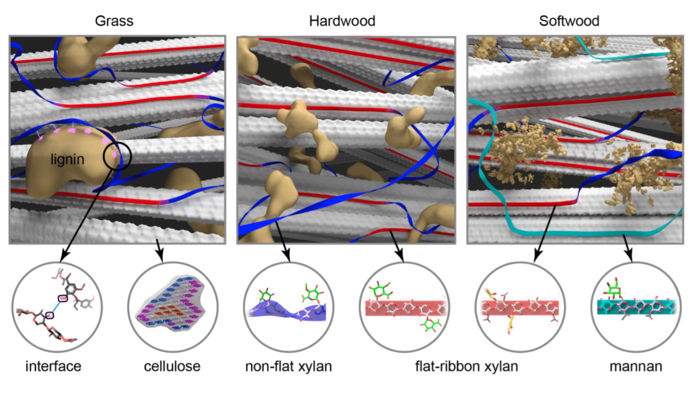Chemists unlock the key to improving biofuel and biomaterial production
Spectroscopy method enables future opportunities for looking at complex biomolecules in different plants
Advertisement
As the world searches for and demands more sustainable sources of energy and materials, plant biomass may provide the solution by serving as a renewable resource for biomaterials and biofuel production. However, until now, the complex physical and chemical interactions in plant biomass have been a challenge in post-harvest processing.

Plant biomass constructed by carbohydrate and aromatic components.
LSU
In a new study published in Nature Communications, LSU Department of Chemistry Associate Professor Tuo Wang and his research team reveal how carbohydrates interact with the aromatic polymer, lignin, to form plant biomass. This new information can help advance the development of better technology to use biomass for energy and materials.
The Wang research team examined the nanoscale assembly of lignocellulosic components in multiple plant species, including grasses and hardwood and softwood species. The grasses contain many food crops, such as maize, and are the primary feedstock for biofuel production in the U.S. Woody plants, often used for building construction materials, have become promising candidates for the next generation of biofuel to reduce the dependence on food crops.
The team used their expertise in solid-state nuclear magnetic resonance spectroscopy to compare the nanoscale organization of the lignin-carbohydrate interfaces across the three plant species and reveal how the structures of biopolymers affect their association with other cell wall components.
“We discovered that the hemicellulose xylan uses its flat structure to bind cellulose microfibrils and primarily relies on its non-flat structure to associate with lignin nanodomains,” Wang said. “However, in the tightly packed woody materials, cellulose is also forced to serve as a secondary interactor with lignin.”
The newly discovered, high-resolution information on the organization of the lignin-carbohydrate interfaces has revised the research of plant biomaterials. Through the spectroscopy method, samples being studied were kept in their native status, without chemical perturbation. Results unveiled structural differences underlying the cell wall construction among the different plants.
The research was conducted by a team comprised of LSU graduate students Alex Kirui and Wancheng Zhao as well as postdoctoral researchers Fabien Deligey and Xue Kang from the Wang research group; Frederic Mentink-Vigier, an expert in Dynamic Nuclear Polarization technique at the National High Magnetic Field Laboratory (Tallahassee, Fla.) who collaborated on the project; and Hui Yang at the Pennsylvania State University, who offered extensive modeling expertise.
This methodology enables future opportunities for looking at complex biomolecules in different plants and engineered mutants, which will assist the development of better technology for the production of biorenewable energy and biomaterials.
Original publication
Other news from the department science
These products might interest you
Most read news
More news from our other portals
See the theme worlds for related content
Topic World Spectroscopy
Investigation with spectroscopy gives us unique insights into the composition and structure of materials. From UV-Vis spectroscopy to infrared and Raman spectroscopy to fluorescence and atomic absorption spectroscopy, spectroscopy offers us a wide range of analytical techniques to precisely characterize substances. Immerse yourself in the fascinating world of spectroscopy!

Topic World Spectroscopy
Investigation with spectroscopy gives us unique insights into the composition and structure of materials. From UV-Vis spectroscopy to infrared and Raman spectroscopy to fluorescence and atomic absorption spectroscopy, spectroscopy offers us a wide range of analytical techniques to precisely characterize substances. Immerse yourself in the fascinating world of spectroscopy!



























































